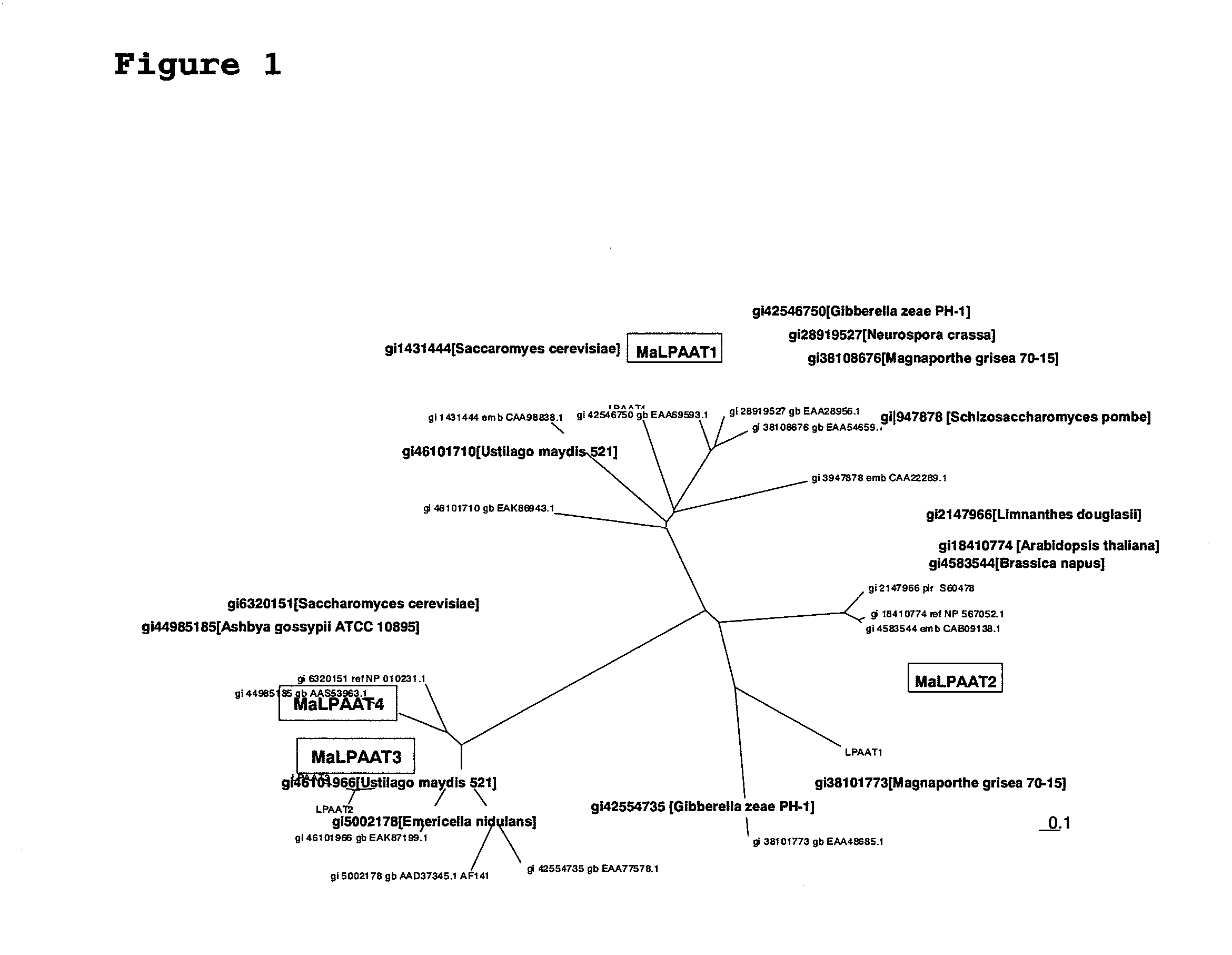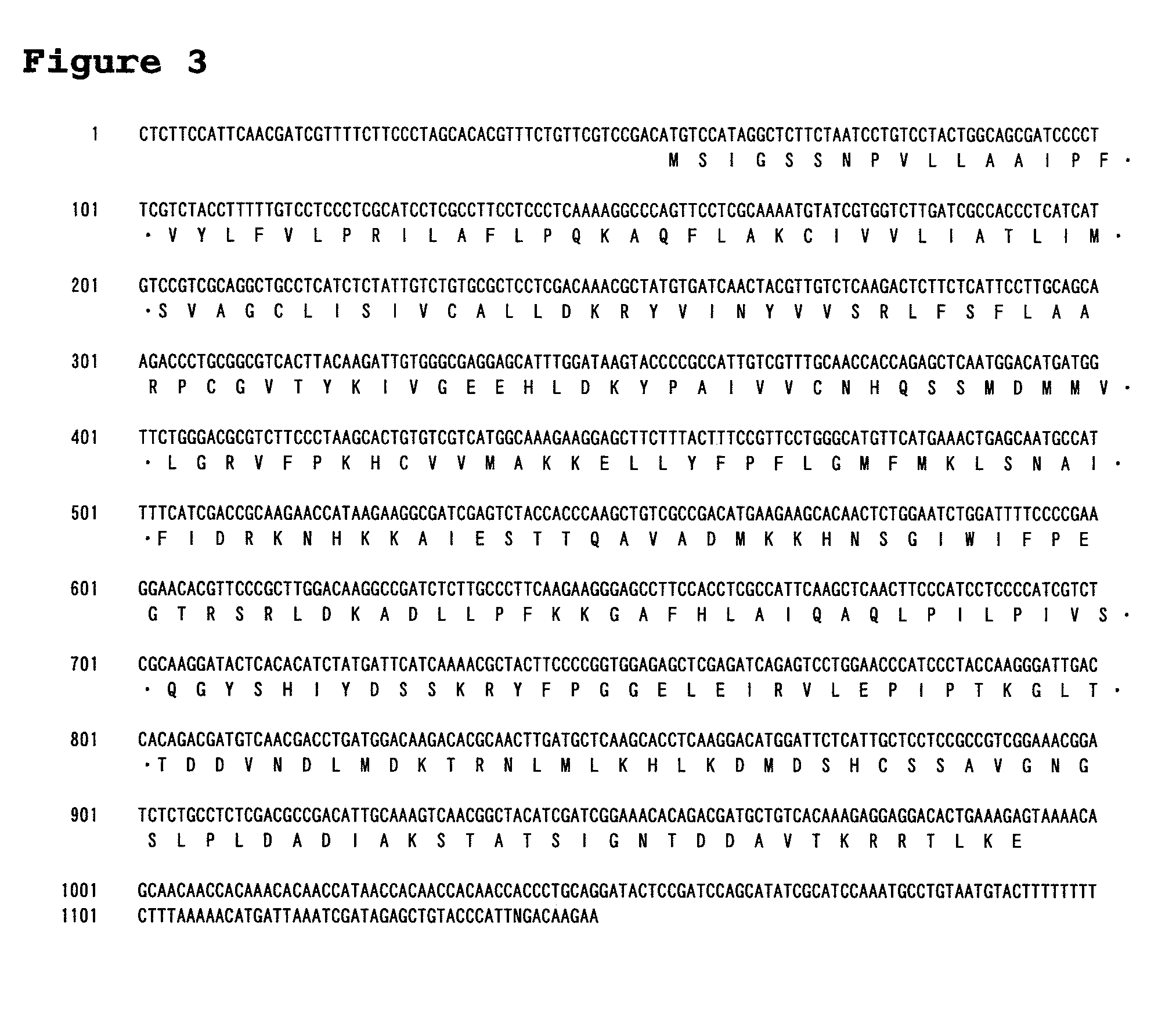Novel lysophosphatidic acid acyltransferase genes
- Summary
- Abstract
- Description
- Claims
- Application Information
AI Technical Summary
Benefits of technology
Problems solved by technology
Method used
Image
Examples
example 1
(1) EST Analysis
[0260]M. alpina strain 1S-4 was inoculated into 100 ml medium (1.8% glucose, 1% yeast extract, pH 6.0) and pre-cultured for 3 days at 28° C. A 10 L culture vessel (Able Co., Tokyo) was charged with 5 L medium (1.8% glucose, 1% soybean powder, 0.1% olive oil, 0.01% Adekanol, 0.3% KH2PO4, 0.1% Na2SO4, 0.05% CaCl2.2H2O, 0.05% MgCl2.6H2O, pH 6.0) and inoculated with the entire pre-cultured product, followed by aerobic spinner culture under conditions of 300 rpm, 1 vvm and 26° C. for 8 days. On days 1, 2 and 3 of culture, glucose was added in an amount corresponding to 2%, 2% and 1.5%, respectively. The cells were collected at each stage of culture (day 1, 2, 3, 6 or 8) to prepare total RNA by the guanidine hydrochloride / CsCl method. Using an Oligotex-dT30mRNA Purification Kit (Takara Bio Inc., Japan), poly(A)+RNA was purified from the total RNA. A cDNA library was prepared for each stage with a ZAP-cDNA GigapackIII Gold Cloning Kit (STRATAGENE), followed by one-pass sequ...
example 2
(1) Cloning of LPAAT Homologs
[0271]SEQ ID NO: 1 contains a CDS of 990 by (SEQ ID NO: 8) and would be a sequence encoding the full-length LPAAT3 gene. The deduced amino acid sequence of a protein (LPAAT3p) encoded by this gene is shown in SEQ ID NO: 2. For PCR amplification of DNA containing this ORF sequence, the following primers were prepared:
Primer I-1:GGATGTCATCAATGTCATCAATAGAG;(SEQ ID NO: 9)andPrimer I-2:CTAACCCCCTCTTCCTCCACCAC.(SEQ ID NO: 10)
The cDNA library on day 3 was used as a template to perform PCR with primers I-1 and 1-2 using ExTaq (Takara Bio Inc., Japan). PCR conditions were set as follows: 94° C. for 2 minutes, and 30 cycles of 94° C. for 1 minute, 54° C. for 1 minute and 72° C. for 2 minutes.
[0272]The amplified fragments were TA-cloned with a TOPO-TA cloning Kit (INVITROGEN CORPORATION). Several clones were confirmed for their nucleotide sequences, and a clone appearing to contain the correct nucleotide sequence of this gene was designated as pCR-LPAAT3.
[0273]SEQ ...
example 3
Measurement of LPAAT Activity
[0292](1) Breeding of Strain Δslc1:URA3
[0293]To obtain the CDS of SLC1 known as a gene responsible for LPAAT activity in yeast, the following primers were prepared:
Primer SLC1-1ggtgaagggggaattcttc;(SEQ ID NO: 45)andPrimer SLC1-2atgtcgacgtggcttaatgcatc.(SEQ ID NO: 46)
[0294]To obtain genomic DNA from Saccharomyces cerevisiae strain S288C, this strain was inoculated into YPD medium (10 ml) and cultured with shaking at 30° C. for 1 day. From 1.5 ml of the culture solution, DNA was extracted with a Dr. GenTLE (for Yeast) kit (Takara Bio Inc., Japan). This was used as a template to amplify the CDS of SLC1 by PCR with primers SLC-1 and SLC-2. The resulting PCR product was digested with restriction enzymes EcoRI and SalI, inserted into the EcoRI-SalI site of vector pUC18, and then confirmed for its nucleotide sequence to obtain plasmid pUC-SLC1. Subsequently, the plasmid pUC-SLC1 was digested with a restriction enzyme SalI, followed by blunt ending and self-liga...
PUM
| Property | Measurement | Unit |
|---|---|---|
| Temperature | aaaaa | aaaaa |
| Fraction | aaaaa | aaaaa |
| Fraction | aaaaa | aaaaa |
Abstract
Description
Claims
Application Information
 Login to View More
Login to View More - Generate Ideas
- Intellectual Property
- Life Sciences
- Materials
- Tech Scout
- Unparalleled Data Quality
- Higher Quality Content
- 60% Fewer Hallucinations
Browse by: Latest US Patents, China's latest patents, Technical Efficacy Thesaurus, Application Domain, Technology Topic, Popular Technical Reports.
© 2025 PatSnap. All rights reserved.Legal|Privacy policy|Modern Slavery Act Transparency Statement|Sitemap|About US| Contact US: help@patsnap.com



